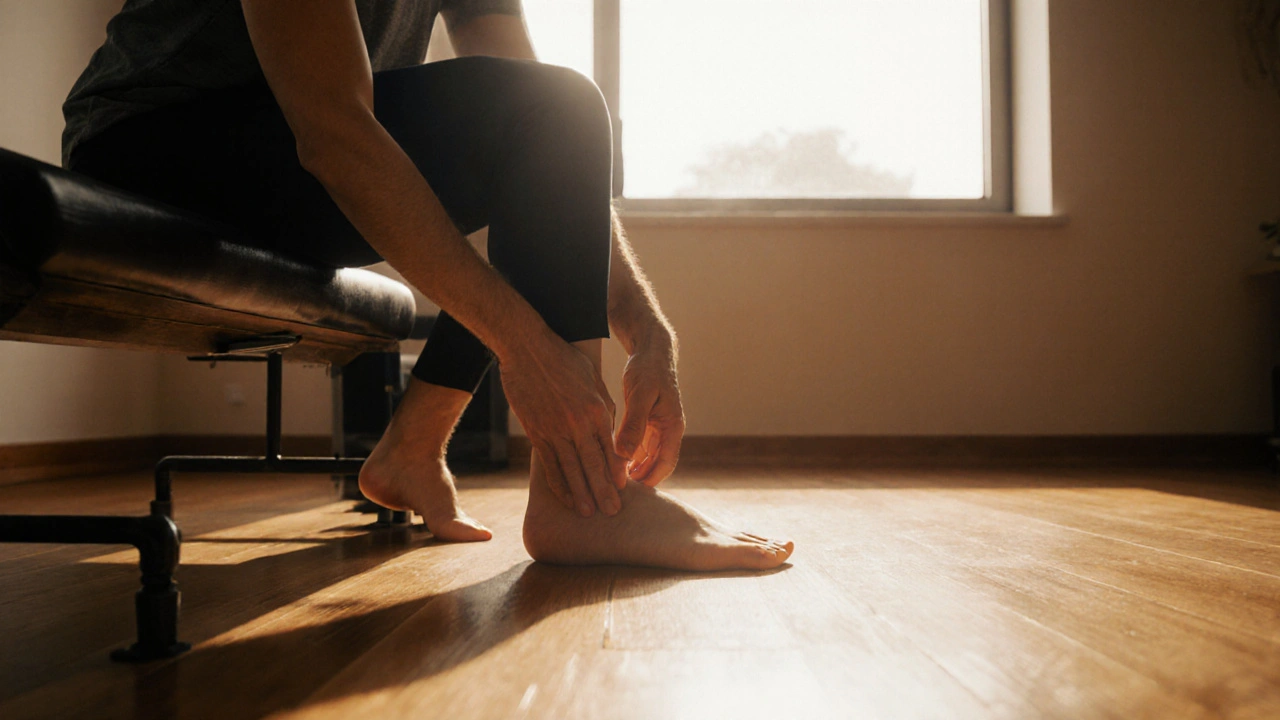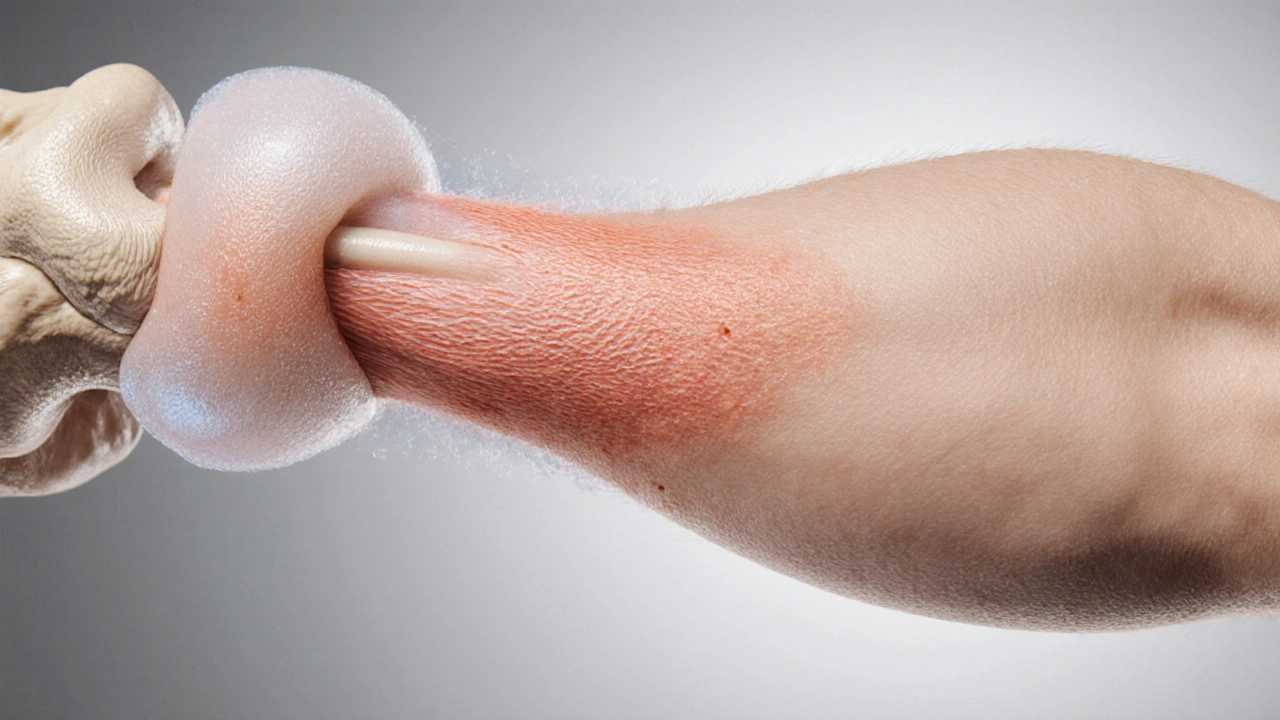Tendonitis Mobility Impact Checker
Assess Your Tendonitis Impact
Answer the following questions about your current symptoms and activity levels to understand how tendonitis might be affecting your joint mobility.
Your results will appear here after answering the questions above.
When you hear the term tendonitis is a painful inflammation of a tendon that connects muscle to bone, you might picture a sore elbow or aching heel, but the real impact goes deeper-right into how your joints move and work. Below we break down what tendonitis does to joint mobility, why it can cripple everyday activities, and what you can actually do to get moving again.
Quick Takeaways
- Tendonitis inflames the tendon, leading to pain, swelling, and stiffness that limit joint range of motion.
- Reduced mobility often stems from protective muscle guarding and altered biomechanics.
- Early diagnosis and targeted physical therapy can restore function in most cases.
- Non‑surgical options-rest, NSAIDs, eccentric exercises-work for the majority of patients.
- Preventive habits like proper warm‑up, gradual load increase, and strength balance are key.
What Exactly Is Tendonitis?
At its core, tendonitis is an inflammatory response that occurs when a tendon is overloaded or subjected to repetitive micro‑trauma. The tendon’s collagen fibers swell, blood flow rises, and pain‑sensory nerves become hyper‑active. Common sites include the rotator cuff (shoulder), Achilles (ankle), wrist extensors (forearm), and patellar tendon (knee).
How Tendonitis Limits Joint Mobility
Joints rely on tendons to transmit muscle forces; when a tendon is inflamed, the body instinctively limits movement to protect the tissue. This protection shows up in three ways:
- Muscle guarding: Muscles surrounding the joint contract reflexively, creating a stiff feeling and reducing the joint’s available range.
- Altered biomechanics: The limb may shift its motion pattern-think of favoring one side when you walk with Achilles tendonitis-which places extra stress on neighboring joints.
- Swelling and pain: Fluid buildup inside the tendon sheath physically blocks smooth gliding, while pain signals inhibit full stretch.
Over time, these changes can lead to secondary issues like joint capsule tightening, reduced synovial fluid circulation, and even early onset osteoarthritis.
Symptoms That Signal Mobility Loss
Typical signs include:
- Localized tenderness that worsens with activity.
- Morning stiffness that eases after light movement.
- Reduced active range of motion (AROM) compared to the opposite side.
- Clicking or grinding sensations if the tendon rubs against bony surfaces.
When you notice any of these, it’s a cue to assess how far the joint can move without pain-often the first step in a functional exam.

How Doctors Diagnose Tendonitis
Clinicians usually start with a physical exam, testing AROM, strength, and palpation for swelling. Imaging may include:
- Ultrasound: Shows real‑time tendon thickening and fluid.
- MRI: Highlights inflammation and helps rule out tears.
The goal is to confirm that the pain source is tendon inflammation, not a tendon rupture or joint arthritis.
Treatment Options: From First‑Aid to Full Recovery
Therapy follows a stepped approach, matching the severity of inflammation and functional loss.
Phase1 - Acute Management
- Rest and activity modification: Avoid the offending motion for 48‑72hours.
- Ice: 15‑20minutes, 3‑4 times a day, to reduce swelling.
- NSAIDs (e.g., ibuprofen 400mg every 6hours) for pain control-use only as directed.
Phase2 - Restoring Mobility
Once pain subsides, gentle range‑of‑motion exercises prevent stiffness. A common protocol involves:
- Passive stretching of the surrounding muscles (e.g., calf stretch for Achilles tendonitis) for 30seconds, 3 repetitions.
- Controlled joint circles to maintain synovial fluid flow.
Phase3 - Strengthening and Eccentric Loading
Research shows eccentric exercises-where the muscle lengthens under load-are especially effective. Example for patellar tendonitis:
- Stand on a step, lower the heel slowly (3‑4seconds) while keeping the knee over the toe.
- Perform 3 sets of 12 repetitions, twice daily.
Consistency over 6‑8weeks typically yields a 70% improvement in pain and function.
When to Consider Injections or Surgery
If symptoms persist beyond three months despite rehab, options include:
- Corticosteroid injection: Provides short‑term relief but may weaken tendon if overused.
- Platelet‑rich plasma (PRP): Emerging evidence suggests it promotes healing in chronic cases.
- Surgical debridement: Reserved for full‑thickness tears or refractory tendonitis.
Rehabilitation Blueprint: Getting Your Joint Back in Shape
A typical rehab timeline spans 8‑12weeks:
- Weeks1‑2: Pain control, gentle ROM, and isometric contractions.
- Weeks3‑5: Introduce light eccentric loading and proprioceptive drills.
- Weeks6‑8: Progress to sport‑specific or work‑specific drills, gradually increasing load.
- Weeks9‑12: Full return to activity, monitoring for any flare‑ups.
Regular check‑ins with a physical therapist help fine‑tune technique and avoid re‑injury.
Prevention: Keep Tendons Happy for the Long Run
Most tendonitis cases stem from overload or poor mechanics. Try these habits:
- Warm up with dynamic stretches-muscles and tendons respond better to movement than static holding.
- Increase training volume by no more than 10% per week; abrupt spikes are a red flag.
- Strengthen opposing muscle groups to maintain balanced joint forces (e.g., hamstring work for knee health).
- Stay hydrated; tendons need adequate collagen synthesis, which depends on water and nutrients like vitaminC.
Comparison of Common Tendon Disorders
| Condition | Primary Cause | Typical Onset | Pain Pattern | Standard Treatment |
|---|---|---|---|---|
| Tendonitis | Acute inflammation from overload | Hours‑to‑weeks | Sharp pain that worsens with activity | Rest, NSAIDs, eccentric rehab |
| Tendinosis | Degenerative collagen changes, chronic overload | Months‑years | Dull ache, stiffness, minimal swelling | PRP, progressive loading, longer rehab |
| Tendon rupture | Sudden overload or severe degeneration | Instant | Severe tearing sensation, loss of function | Surgical repair, immobilization, rehab |

Frequently Asked Questions
Can tendonitis become permanent?
If left untreated, chronic inflammation can turn into tendinosis-a degenerative state that’s harder to reverse. Early rehab usually prevents permanent loss of function.
Is it safe to keep exercising with tendonitis?
Light, pain‑free activity is actually beneficial; it promotes blood flow and prevents stiffness. High‑impact or aggravating movements should be paused until pain subsides.
How long does recovery usually take?
Mild cases often improve within 2‑4weeks, while moderate tendonitis may need 8‑12weeks of structured rehab.
Do corticosteroid injections cure tendonitis?
They can reduce pain quickly, but they don’t repair damaged fibers. Repeated injections may weaken the tendon, so they’re used sparingly.
What lifestyle changes help prevent future flare‑ups?
Gradual load progression, regular eccentric strengthening, proper footwear, and adequate nutrition (especially vitaminC and collagen‑supporting foods) are key preventive steps.
By understanding how tendonitis disrupts joint mobility and following a structured rehab plan, you can regain smooth, pain‑free movement and keep your joints healthy for years to come.

Suzy Stewart
October 1, 2025 AT 15:22Wow, this guide on tendonitis really nails the basics and gives you a practical way to self‑assess your mobility 🙌. I love how it breaks down the pain levels and stiffness questions into a simple checklist. It’s encouraging to see that even mild cases can be tracked without a doctor’s visit. Keep an eye on that morning stiffness – it often eases after a few moves, but don’t ignore it! If you notice reduced range of motion, start gentle stretching right away. Consistency with light activity can actually help reduce tenderness over time 😊. Remember to listen to your body and adjust intensity based on the scores you get. This tool could be a game‑changer for athletes and desk‑jockeys alike.
Traven West
October 10, 2025 AT 21:35Honestly, the checklist feels like a gimmick – just pick “mild” and you’re done. Grammar matters: “morning stiffnes” is misspelled. Stop over‑complicating simple symptoms.
Gulam Ahmed Khan
October 20, 2025 AT 03:49Great effort! 😊 This kind of self‑evaluation can empower people to take early action. The pain level slider is a nice visual cue, and adding a note about anti‑inflammatory foods would be helpful. Keep the optimism flowing – you’ve got this!
John and Maria Cristina Varano
October 29, 2025 AT 09:02meh i dont see the point of another quiz you could just google stuff its same old same old
Melissa Trebouhansingh
November 7, 2025 AT 15:15One must appreciate the deliberate construction of this exposition on tendonitis, for it deftly traverses the labyrinthine corridors of musculoskeletal pathology whilst simultaneously offering the layperson a palatable means of self‑evaluation. The author, in a commendable display of didactic ambition, has elected to eschew the typical clinical jargon that so often alienates the uninitiated, opting instead for a vernacular that is both accessible and intellectually stimulating. Each query within the mobility impact checker is meticulously crafted, guiding the respondent through a nuanced gradient of pain, stiffness, and functional limitation. By integrating a quantifiable scoring system, the piece transcends mere anecdote, bestowing upon its audience a metric by which to gauge their own condition. Moreover, the interstitial advice, though succinct, is suffused with a prescient awareness of contemporary physiotherapeutic modalities. It subtly hints at the virtues of eccentric loading, cryotherapy, and the judicious use of non‑steroidal anti‑inflammatory agents, thereby enriching the reader’s therapeutic repertoire. The inclusion of a visual interface, while ostensibly elementary, serves a dual purpose: it democratizes data collection and engenders a sense of agency among users. In an era where digital health tools proliferate, this checker stands out for its elegant synthesis of form and function. While some may critique its brevity, such conciseness is, in fact, a strategic concession to user fatigue, ensuring adherence without sacrificing informational integrity. Ultimately, this article bridges the oft‑cavernous divide between clinical acumen and public health education, rendering it an indispensable adjunct for anyone grappling with tendonitis‑related mobility constraints.
amanda luize
November 16, 2025 AT 21:29Let's not be fooled by the surface‑level positivity of this post – behind the glossy UI lies a potential data‑harvesting scheme orchestrated by shadowy entities. The questionnaire's seemingly innocuous questions could be cross‑referenced with wearable tech data to construct a detailed biomechanical profile, which, in the hands of corporate overlords, might be weaponized for profit. Also, the advice given is suspiciously generic; anyone with a basic physiotherapy textbook could rewrite it. Vigilance is essential, trust no one.
Chris Morgan
November 26, 2025 AT 03:42This tool, while well‑intentioned, may oversimplify complex tendon pathologies.
Pallavi G
December 5, 2025 AT 09:55Hey folks, just wanted to add that staying hydrated and incorporating omega‑3 rich foods can actually support tendon health. Also, gentle eccentric calf raises are fantastic for Achilles tendonitis – do them slowly and feel the stretch. Remember, consistency beats intensity when you're recovering.
Rafael Lopez
December 14, 2025 AT 16:09Excellent resource, however, consider adding a note about consulting a qualified physiotherapist before embarking on any rigorous regimen, especially if you have comorbidities, and always ensure proper footwear, adequate warm‑up, and gradual progression of activity intensity.
Craig Mascarenhas
December 23, 2025 AT 22:22Another shiny form from the elite health industry pushing us to self‑diagnose while they collect data. It's all part of the grand plan to keep the masses dependent on paid apps and hidden agendas.